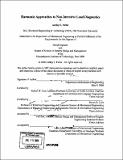| dc.contributor.advisor | Robert W. Cox and Steven B. Leeb. | en_US |
| dc.contributor.author | Fuller, Ashley E. (Ashley Eliot) | en_US |
| dc.contributor.other | System Design and Management Program. | en_US |
| dc.date.accessioned | 2009-03-16T19:50:40Z | |
| dc.date.available | 2009-03-16T19:50:40Z | |
| dc.date.copyright | 2008 | en_US |
| dc.date.issued | 2008 | en_US |
| dc.identifier.uri | http://hdl.handle.net/1721.1/44847 | |
| dc.description | Thesis (Nav. E.)--Massachusetts Institute of Technology, Dept. of Mechanical Engineering; and, (S.M.)--Massachusetts Institute of Technology, System Design and Management Program, 2008. | en_US |
| dc.description | Includes bibliographical references (p. 88-90). | en_US |
| dc.description.abstract | The Non-Intrusive Load Monitor (NILM) is a system that monitors, records and processes voltage and current measurements to establish the operating characteristics of individual loads on a load center from a single aggregate measurement. The NILM can also be used to actively monitor degradation or diagnose specific system failures. Current NILM research conducted at the Massachusetts Institute of Technology's Laboratory for Electromagnetic and Electronic Systems (LEES) is exploring the application and expansion of NILM technology for the use of monitoring a myriad of electromechanical loads. This thesis presents a fundamental guide to understanding NILM operation using laboratory bench testing and demonstrates its potential to detect an array of electric machine failures before they become catastrophic. The NILM's ability to the monitor the current spectrum of electric machines can be used to immediately diagnose multiple common system casualties and detect unusual system operation. Clean current spectrum regions can be exploited by selecting induction machine design characteristics that result in eccentric modulation frequencies occurring in areas free of supply frequency harmonics. Current spectrum analysis was used to demonstrate the NILM's potential to monitor multiple machines from an aggregate source and discuss intersystem impedances. It can be shown that multiple machines with slightly varied physical characteristics, such as induction motor rotor slots, coupled with using clean current spectral regions support automated diagnostic system development. Measurements and experimentation were conducted in the LEES laboratory and the Industrial Support Center electric shop, Boston. | en_US |
| dc.description.statementofresponsibility | by Ashley E. Fuller. | en_US |
| dc.format.extent | 90 p. | en_US |
| dc.language.iso | eng | en_US |
| dc.publisher | Massachusetts Institute of Technology | en_US |
| dc.rights | M.I.T. theses are protected by
copyright. They may be viewed from this source for any purpose, but
reproduction or distribution in any format is prohibited without written
permission. See provided URL for inquiries about permission. | en_US |
| dc.rights.uri | http://dspace.mit.edu/handle/1721.1/7582 | en_US |
| dc.subject | Mechanical Engineering. | en_US |
| dc.subject | System Design and Management Program. | en_US |
| dc.title | Harmonic approaches to non-intrusive load diagnostics | en_US |
| dc.type | Thesis | en_US |
| dc.description.degree | S.M. | en_US |
| dc.description.degree | Nav.E. | en_US |
| dc.contributor.department | System Design and Management Program. | en_US |
| dc.contributor.department | Massachusetts Institute of Technology. Department of Mechanical Engineering | |
| dc.identifier.oclc | 301595521 | en_US |
